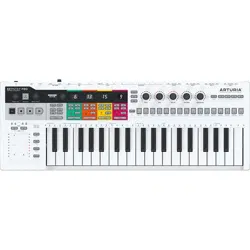Loading ...
Loading ...
Loading ...

5.2.2. HOLD and the Arpeggiator
The KeyStep Pro gives you some control over the Patterns that are generated:
• The arpeggiator picks notes within the available octaves as defined by the Arp
Octave function. To change the arpeggio range, hold down 'Shift' and press one
of the Arp Octave keys (-1, 0, +1, +2 or +3).
When you find a particularly interesting Pattern, press the HOLD button and refrain from
touching the keyboard; whatever keys you held down on the keyboard will remain active,
even after you lift your fingers. The arpeggio will continue playing, and you'll have an extra
hand to tweak knobs. As long as you keep at least one note depressed, you can extend an
arpeggio to a maximum length of 16 notes.
After you lift your fingers from the keyboard, playing a new chord will start a new arpeggio
that will replace the arpeggio that was just playing.
!: This feature offers some interesting creative options: if you have set an arpeggio to play in the
order you press the keys of the chord (by using the 'Shift' + Order key), you can repeatedly play the
notes of the same chord in different orders, thus emphasizing different notes in the chord. If you play
with your attention focused on the velocity of the notes in the chord, you can make this effect even
more pronounced.
You can offset an arpeggio on hold in time using the Time Shift encoder.
This feature enables you to delay the active arpeggio compared to other arpeggios. To get a
feel for how this works, create two similar arpeggios in Track 2 and Track 3 with the same
time-division and set them on hold. Now activate Track 3 and turn the Timeshift encoder to
the right: the arpeggio in Track 3 will now shift forward in time.
!: Another thing to try is to combine an arpeggio held in Poly mode with an arpeggio in Exclu
(exclusive pendulum) or Inclu (inclusive pendulum) mode. The polyphonic arpeggiation will repeat all
notes in the arpeggio simultaneously, thus forming a block-chord background for the second arpeggio.
5.2.3. Transposing an Arpeggio
To transpose a running arpeggio press Hold so you can lift your fingers from the keyboard,
hold the transpose button and press keys on the keyboard to transpose the arpeggio.
♪: When adding new notes to the arpeggio, the new notes will be added to the transposed version of
the arpeggio.
64 Arturia - User Manual Keystep Pro - Making Tracks
Loading ...
Loading ...
Loading ...
